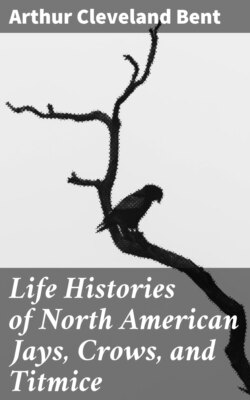Читать книгу Life Histories of North American Jays, Crows, and Titmice - Arthur Cleveland Bent - Страница 32
На сайте Литреса книга снята с продажи.
CYANOCITTA STELLERI CARBONACEA Grinnell
COAST JAY
ОглавлениеTable of Contents
The coast jay, or Grinnell’s jay, as Ridgway (1904) calls it, is very evidently quite intermediate in characters between stelleri on the north and frontalis on the east and south, for Dr. Grinnell (1900b) in naming it described it as “intermediate in size * * * between C. stelleri and C. stelleri frontalis. Dorsal surface sooty-black as in stelleri, but with blue on forehead nearly as extended as in frontalis. Tint of blue of posterior lower parts paler than in stelleri, and extending further forward into pectoral region, as in frontalis.” Furthermore, its range, the “coast region of Oregon and California, from the Columbia River south to Monterey County,” is just where one would expect to find the two previously named forms to intergrade. This is just another case, like annectens, where the naming of an intermediate immediately produces two more sets of intergrades. Dr. Grinnell (1900b) says further: “C. stelleri annectens from Idaho resembles carbonacea somewhat closely, but the white spot over the eye distinguishes both C. s. annectens and C. s. macrolopha [= diademata] of the Northern and Southern Rocky Mountain regions, respectively, from the parallel Pacific Coast races, carbonacea and frontalis, neither of which has any trace of such a marking.”
What has been written about the nesting habits, eggs, plumages, food and general habits of the other Pacific coast races of the species would apply very well to this subspecies. The measurements of 40 eggs average 30.6 by 22.5 millimeters; the eggs showing the four extremes measure 33.1 by 22.4, 31.1 by 24.0, and 26.6 by 21.2 millimeters.
